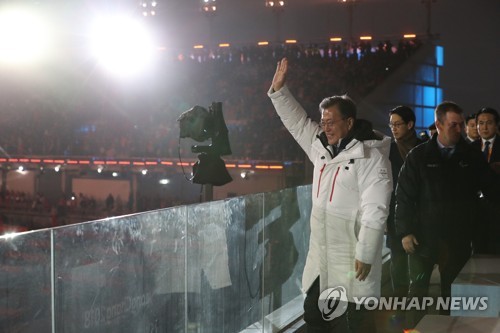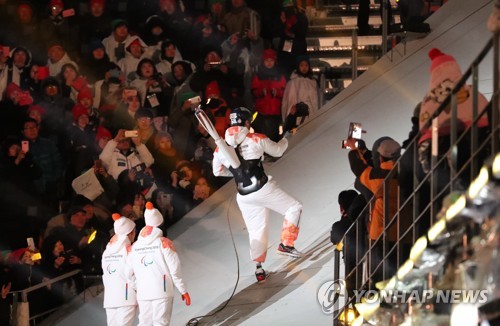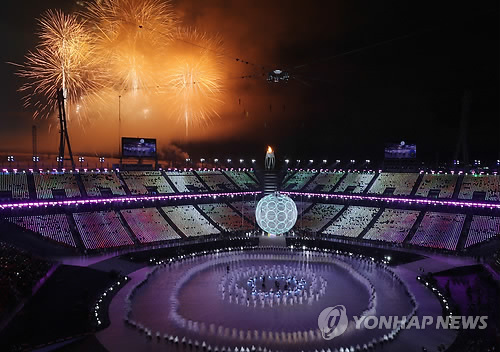The 2018 PyeongChang Winter Paralympic Games kicked off on Friday with an opening ceremony emphasizing passion and coexistence.
Taking "Passion Moves Us" as its theme, the opening ceremony of the first Winter Paralympics in South Korea took place at the 35,000-seat Olympic Stadium in PyeongChang, Gangwon Province.
The Paralympics, which follows last month's Winter Olympic Games, will be held in PyeongChang and neighboring cities Gangneung and Jeongseon through March 18. It will be the largest Winter Paralympics ever, with 570 athletes competing for 49 nations. There are a record 80 gold medals up for grab.

The ceremony, put together by executive creative director Kim Moon-tae, started with an introductory video that symbolically showed the passion of the athletes boiling the mercury of a thermometer. The countdown began as a para ice hockey player shot a "flaming puck" that broke the screen. As the count reached zero, the ground froze up, and fireworks signaled the opening of the winter festival.
Shin Myeong-jin, an amputee performer with a prosthetic arm and legs, then appeared on the center stage beating a giant traditional drum. It was a newly interpreted percussion performance of the traditional "bin-rye," the welcoming ceremony for important guests visiting the royal court of Korea in earlier times.
As the performance of various traditional drums began, the circular stage in the center rose. The powerful sound of many beats combined to convey a message of harmony. A hundred dancers then joined the feast with elegantly choreographed movements.
The emblem of the PyeongChang Paralympic Winter Games was then mapped on the stage and the welcome message was displayed.
The performances were put on hold momentarily as Taegeukgi, the South Korean national flag, was transported into the stadium by eight South Korean Paralympians -- four in wheelchairs -- along the frozen waterway depicted on the ground. The stage was then colored with the red-and-blue taegeuk symbol.

Hwang Young-taek and Kim Hyuk-gun, two singers with physical impairments, together with an all-wheelchair choir sang the national anthem.
The Parade of Athletes followed, with athletes from 49 nations walking into the open-air arena to electronic arrangements of South Korean traditional music. As per tradition, the order of the parade was determined in the order of the host nation's alphabet -- which is "hangeul" in South Korea.
Greece, the birthplace of the modern Olympic Games, was the first nation to enter. South Korea was the last to appear. North Korea was 34th, just behind Japan.
The South and the North originally planned to have a joint march like they did at the Olympics, but the two parties' plan was scrapped Thursday after they failed to narrow their differences on using a Korean Unification Flag showing the South Korean eastern islets of Dokdo.
The North previously said that it wanted the flag to show Dokdo. The South, however, wanted to have the Korean Unification Flag without Dokdo to respect the International Paralympic Committe (IPC)'s recommendation not to politicize sports events.
Dokdo, called Takeshima in Japan, consists of a set of rocky islets lying close to the Korean Peninsula in the East Sea. It has long been a recurring source of tension with Japan.
Although they marched seperately, North Korea, its flag carried by sit skier Kim Jong-hyon, still drew loud cheers from the South Korean-dominated audience. But it was the athletes from the host nation that rocked the stadium when they entered, with Nordic skier Sin Eui-hyun serving as the team's flagbearer.

Segments highlighting people with impairments' dreams and visions then took the center stage. The performance showed a girl with a visual impairment drawing a world of imagination and hope. In the end, it showed children and Paralympians dancing to a song with sign language motions, reflecting a message that PyeongChang is a place where the dream of becoming one comes true.
Then Lee Hee-beom, president of PyeongChang's organizing committee, and Andrew Parsons, president of the IPC, each took the stage to give speeches.
"It is my sincere hope and expectation that the PyeongChang 2018 Paralympic Games will serve as a cornerstone to create a caring and sharing society without discrimination or prejudice well beyond the values of peace and harmony, inspiration and jubilation," Lee said. "In addition, the festival of PyeongChang 2018 will shed the 'Light of Hope' on the future of all people across the world yearning for peace beyond the Korean peninsula and Northeast Asia."
Parsons emphasized the power of Paralympic sport, saying it not only changes lives but also changes the world.
"From tomorrow, Paralympic athletes will turn their dreams into reality," he said. "They will perform feats that some might not even dare to dream about. Speed, skill, strength, endurance and intelligence; tremendous abilities that will at first surprise you, but ultimately will inspire and excite you."
After they had spoken, South Korean President Moon Jae-in officially declared the PyeongChang Winter Paralympics open as specators and guests at the stadium, including International Olympic President Thomas Bach and U.S. homeland security chief Kirstjen Nielsen, celebrated.
Following the speeches, the Paralympic flag was carried in by future Paralympians. Then representatives of the athletes, officials and coaches for the PyeongChang Paralympics swore the Paralympic oath.

Another artistic segment followed that featured a "Wheel of Passion" symbolizing the passion that leads to equality and harmony and an energy that erases the boundaries of division. After dancers performed with wheelchairs, the Wheel started to rise and the petals that represent the four Paralympic values -- courage, determination, inspiration and equality -- engulfed the Wheel and created the "Sphere of Coexistence."
Then it was time for the cauldron lighting. The final torch relay inside the stadium was a parade of moments of coexistence. Para Nordic skiers from the two Koreas -- the South's Choi Bo-gue and the North's Ma Yu-chol -- carried the Paralympic torch together into the open-air arena.
The two sit skiers then passed the flame to South Korean cross-country skier Seo Vorami and Canadian coach Kaspar Wirz, who represented coexistence in the world.
Up next was a moment of coexistence of generations as triathlon athlete Park Eun-chong and his son Park Ji-hoon, who has six types of rare disease, carried the torch together.
The two were followed by visually impaired skier Yang Jae-rim and her guide Go Eunsori, who together symbolized coexistence of the impaired and non-impaired.

As they went up the stairway to the cauldron, South Korean ice sledge hockey captain Han Min-su carried the torch on his back and rope climbed the slope.
In the end, the Paralympic cauldron was lit by two curlers who represented the coexistence sports at the Paralympic and Olympic Games. Kim Eun-jung, a member of South Korea's silver medal-winning women's curling team at the PyeongChang Winter Olympics, and Seo Soon-seok, a member of wheelchair curling team at the PyeongChang Winter Paralympics, brought the flame to a small "sphere of coexistence" that eventually lit the moon-jar shaped cauldron at the Olympic Stadium and colored the sky with fireworks.
The flame for the PyeongChang Paralympics had been first born in five local cities before being united on Saturday with three other flames -- a flame representing the 1988 Seoul Summer Paralympic Games, a flame from Stoke Mandeville in Britain, the birthplace of the Paralympics, and a digitally created flame. A total of 800 torchbearers participated in groups of two to complete the 2,018 kilometer distance.

After the moon-shaped white porcelain cauldron, which was also used at the Olympics, was lit with the sacred flame, the "Sphere of Coexistence" turned into a sun emitting bright red light. It then became the white full moon as the ceremony concluded with a moonlight dance. Soprano Sumi Jo and singer Sohyang gave the final performances, singing the PyeongChang Paralympics song "Here as ONE." It was followed by an electronic music party featuring CLON, a male dance duo whose Kang Won-rae is paralyzed from waist down, and traditional singers Yu Ji-sook and Park Ae-ri. (Yonhap)


